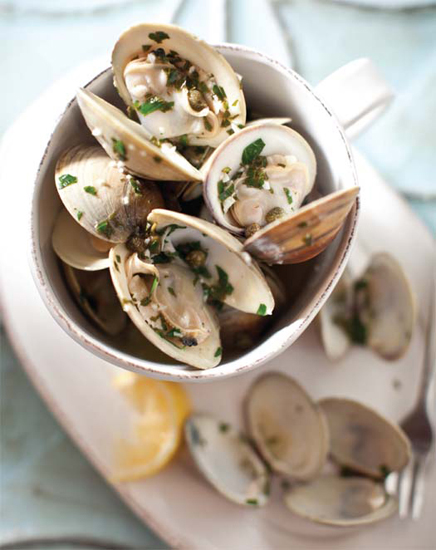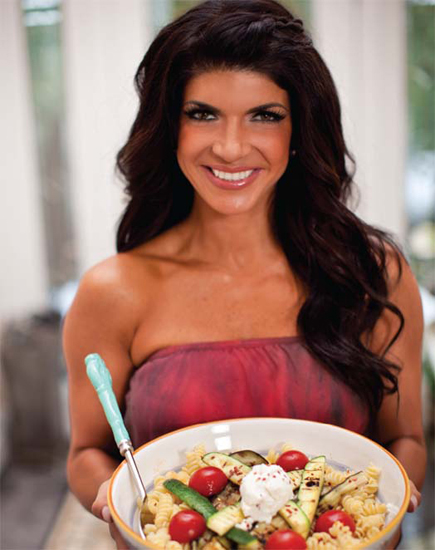Fabulicious!: On the Grill (19 page)
Read Fabulicious!: On the Grill Online
Authors: Teresa Giudice


Â
Make 4 servings
If you've ever been to an Italian cookout, you've probably seen a few large, disposable aluminum pans on the grill. We use those for cooking wet things that we want to mix and mingle, like clams and this yummy lemon-caper butter sauce. You can use littleneck or cherrystone clamsâjust know the larger cherrystones take a little longer to cook.
48 littleneck clams
¼ cup extra-virgin olive oil
4 tablespoons (½ stick) unsalted butter
6 garlic cloves, minced
¾ cup dry white wine, such as Pinot Grigio
¼ cup fresh lemon juice
2 tablespoons drained and rinsed capers, coarsely chopped if large
2 tablespoons finely chopped fresh flat-leaf parsley
Lemon wedges, for serving
Hot red pepper sauce, for serving
1.
Scrub the clams well under cold running water. Transfer to a big bowl or pot and add enough cold salted ice water to cover. (How much salt? The water should taste salty, but not as strong as sea water.) Let stand for 1 to 2 hours. Drain well.
2.
Preheat the grill for direct cooking over medium heat (400°F).
3.
Place a large disposable aluminum foil roasting pan on the cooking grate. Add the oil, butter, and garlic and cook, stirring often, until the butter is melted and the garlic is fragrant and softened, about 3 minutes. Stir in the wine, lemon juice, capers, and parsley. Add the clams and close the grill lid.
4.
Cook, occasionally shaking the pan, until the clams have opened, 10 to 15 minutes. Discard any unopened clams. Remove the pan from the grill. Using tongs, divide the clams among four deep bowls, and top with equal amounts of the cooking liquid. Serve hot with the lemon wedges and hot pepper sauce.
Â
  Â
The No-Cheese-on-Fish “Rule”
  Â
* * *
S
ome Italians and Italian-Americans act like putting any kind of cheese on any kind of fish is completely taboo. It's really not. I get that you don't want to drown out the subtle flavors of seafood with sharp-tasting cheese, but a tiny sprinkling isn't going to overpower anything. In fact, I think it can enhance the flavors of some seafood.
So where did this “rule” come from? No one really knows. It doesn't seem to be for religious reasons, since even though the Catholic Church used to rule no meat
or
dairy on Fridays, we had no problem putting cheese on nonseafood meat the other days of the week. And while some Italian grandmas used to say any milk product with fish would “make you sick,” that's not true. Maybe back before refrigeration, there was a concern that the strong taste of cheese could “hide” the taste of spoiled fish, and you could get sick from that, but that's hardly the case any more.
More likely, it has to do with simple geography. For the most part, people in the regions of Italy that fish didn't have cows for milk, and the cattle farms that were landlocked didn't have fresh fish. I'm not sure it was really a rule as much as the people who fished a lot just didn't have cheese.
Even today, there isn't the same availability of ingredients in Italy as there is in America. One of my friends was in Tuscany recently, and his hosts were making a big deal out of how their family in Sicily was FedEx-ing some fresh mozzarella to them. Here, we would just walk into Whole Foods and buy it.
So feel free to put cheese on your fish. (In a respectful way of course. Don't go all “Olive Garden” on me!) You're not really breaking any rules, you won't get your “honorary Italian” status revoked, and if anyone gives you any grief, you can send âem my way!
Â
Makes 4 servings
I know, I knowâI've heard all the Italian-American chefs say the same thing: never, ever put cheese on seafood. Here's the deal: I'm not a chef. I am a true Italian though, and I promise you, this is worth breaking the rules for! The sharp Parmesan is amazing paired with the mellow scallops. Try to get the big “dry” scallops, which weigh about 1-ounce each. Also, to keep the bread-crumb coating from burning, the grill temperature should be medium (around 400°F)ânot as high as we use for other seafood recipes. The scallops are skewered to help to turn them, but these are not “kebabs” in the traditional sense, with vegetables included with the seafood.
Special Equipment: 4 metal grilling skewers
16 large scallops, preferably dry, about 1 ounce each
2 tablespoons extra-virgin olive oil, plus more for drizzling on the scallops and greasing the grate
½ teaspoon salt
½ teaspoon freshly ground black pepper
â
cup plain dry bread crumbs
2 tablespoons freshly grated Parmesan cheese
2 tablespoons finely chopped fresh flat-leaf parsley
2 garlic cloves, minced
Lemon wedges, for serving
1.
Lightly brush the scallops all over with oil and season with the salt and pepper.
2.
Mix ix the bread crumbs, Parmesan cheese, parsley, garlic, and 2 tablespoons of oil in a medium bowl. In batches, add the scallops and turn to coat completely in the breadcrumb mixture. Thread 4 scallops on each of 4 metal grilling skewers. Place the skewers on a plate and refrigerate to set the coating for 30 minutes.
3.
Preheat the grill for direct cooking over medium heat (400°F).
4.
Lightly oil the cooking grate. Drizzle a little more oil over the scallops. Place the scallops directly on the grill and close the lid. Cook, turning occasionally, with the lid closed as much as possible, until the coating is golden brown and the scallops are opaque and feel firm when pressed with a fingertip, about 8 minutes. Remove the scallops from the grill. Slide the scallops off the skewers and serve hot with the lemon wedges.
Â
Makes 6 servings
Salsa verde
is a green sauce similar to pesto: it's uncooked, made from herbs (in this case, parsley instead of basil), and can be served with about a zillion different foods. For example, add chunks of bell peppers to the skewers, if you wish. For this recipe, the thin, inexpensive skewers sold at most supermarkets work better than the flat-bladed metal “kebab” variety.
Special equipment: 8 thin metal grilling skewers
Salsa Verde:
1½ cups packed fresh flat-leaf parsley
1 scallion, white and green parts, coarsely chopped
Finely grated zest of 1 lemon
¼ cup fresh lemon juice
¼ cup drained and rinsed capers
1½ teaspoons anchovy paste
2 garlic cloves, crushed under the flat side of a knife and peeled
½ cup extra virgin olive oil
Salt and freshly ground black pepper
Shrimp Skewers:
36 jumbo (21 to 26 count) shrimp, peeled and deveined
2 tablespoons extra-virgin olive oil
¼ teaspoon salt
¼ teaspoon freshly ground black pepper
1.
To make the salsa:
Process the parsley, scallion, lemon zest and juice, capers, anchovy paste, and garlic in a food processor or blender until coarsely chopped. With the machine running, gradually pour in the oil to make a rough-textured sauce. Season with salt and pepper. Transfer to a medium bowl and cover. Let stand at room temperature for 1 to 2 hours to allow the flavors to blend. (The salsa verde can be refrigerated for up to 3 days. Bring to room temperature before using.)
2.
Preheat the grill for direct cooking over high heat (500°F).
3.
To make the shrimp skewers:
Have ready 8 thin metal skewers ready. Toss the shrimp, oil, salt, and pepper together in a large bowl to coat. Hold 2 metal skewers parallel to each other. Curving the shrimp into its natural “C” shape, thread the shrimp onto the skewers, leaving a little room between the shrimp. (The exact number of shrimp per skewer isn't important.)
4.
Place the skewered shrimp on the cooking grate and close the grill lid. Grill until the edges of the shrimp look opaque, about 2 minutes. Turn the skewers and continue cooking, with the lid closed, until they are completely opaque and feel firm when pressed with a
fingertip, about 2 minutes more. Remove the skewers from the grill and slide the shrimp off the skewers.
5.
Spoon about 3 tablespoons of the salsa verde onto each of six dinner plates. Top each with 6 shrimp. Serve hot.
It's easier to grill shrimp if they are skewered. To keep them from spinning on the skewer, thread them side-by-side onto two skewers, and they'll stay put.
  Â
Spicy Salsa
  Â
* * *
W
hen most people hear the world salsa, they think of the spicy dip made from chopped veggies and eaten with tortilla chips. But salsa actually means the same thing in both Spanish and Italian: “sauce.” Unlike the American definition of “sauce” as a thin liquid, Italian and Spanish salsa is deliciously chunky and raw. It's an easy accompaniment for almost any dish, and while the Italian version isn't necessarily spicy, you can always heat it up by adding a couple of minced pepperoncini.


